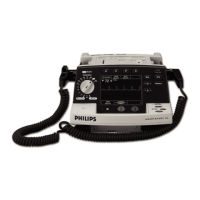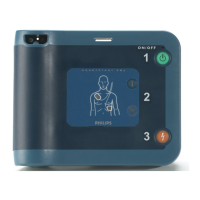
Do you have a question about the Philips HeartStart XL+ and is the answer not in the manual?
| Device Type | Defibrillator/Monitor |
|---|---|
| Defibrillator Waveform | Truncated Exponential Biphasic |
| Pacing Rate | 30-180 ppm |
| Modes | Manual, AED |
| Battery Type | Rechargeable Lithium Ion |
| Pacer Type | Demand |
| Pacing Output | 0 to 140 mA |
| Printer | Integrated strip printer |
| Monitoring | ECG |
| Connectivity | Ethernet, RS232 |
| Operating Temperature | 0°C to 50°C |
| Storage Temperature | -20°C to 60°C |
| Humidity Range | 5% to 95% (non-condensing) |
| Energy Selection | 2-200 Joules |
| Weight | 6.4 kg |
Lists different versions and print dates of the manual.
Provides contact and location details for the device manufacturer.
Instructions to find conformity statements online.
Information on chemical substances per REACH.
Explains warning, caution, note, and icon meanings.
Lists common abbreviations used in the manual.
Identifies the intended audience for this manual.
Information on accessing service training resources.
General introduction to the chapter's topics.
Overview of the maintenance chapter.
Procedures for updating device software.
Routine maintenance procedures for the device's battery.
Steps to calibrate the Non-Invasive Blood Pressure module.
Procedures for testing the NBP module.
Maintenance procedures for the EtCO2 monitoring option.
Introduction to troubleshooting topics and sections.
Lists required tools for troubleshooting.
Information on ordering spare parts.
Explains the status and meaning of the RFU indicator.
Description of the device's automatic self-tests.
How to view and print automated test results.
Manual readiness checks for the device.
Procedures for performing operational checks.
Tests available within the device's Service Mode.
How to access and manage device error logs.
A systematic guide for isolating and resolving issues.
Visual diagrams to guide troubleshooting steps.
Detailed troubleshooting for specific device components.
Introduction to the repair procedures.
Specifies qualifications for performing repairs.
Explains the subassembly replacement approach to repairs.
Contact information and procedures for obtaining service.
Information on tracking critical components during repair.
Important notes and precautions for internal repairs.
Procedures for replacing external device parts.
General overview of internal assemblies.
Procedures for servicing rear chassis components.
Procedures for servicing front chassis components.
Steps for reassembling and sealing the device.
Introduction to verifying device performance post-repair.
Details the testing levels required based on repair type.
Lists the equipment needed for verification and safety tests.
Summarizes performance verification tests and inspections.
Instructions for performing inspections and tests.
Introduces the appendix content on parts and accessories.
Important notes regarding ordering parts and components.
Instructions for ordering spare parts for the device.
Instructions for ordering consumables and accessories.
Visual representation of shock and pacing pulse waveforms.
Schematic of device component interconnections.
Functional descriptions of major device assemblies.
Detailed explanations of device functions like ECG, Pacing, CO2.
Section for recording initial device details and issue description.
Section for documenting diagnostic findings.
Section for recording parts replaced and calibration performed.











